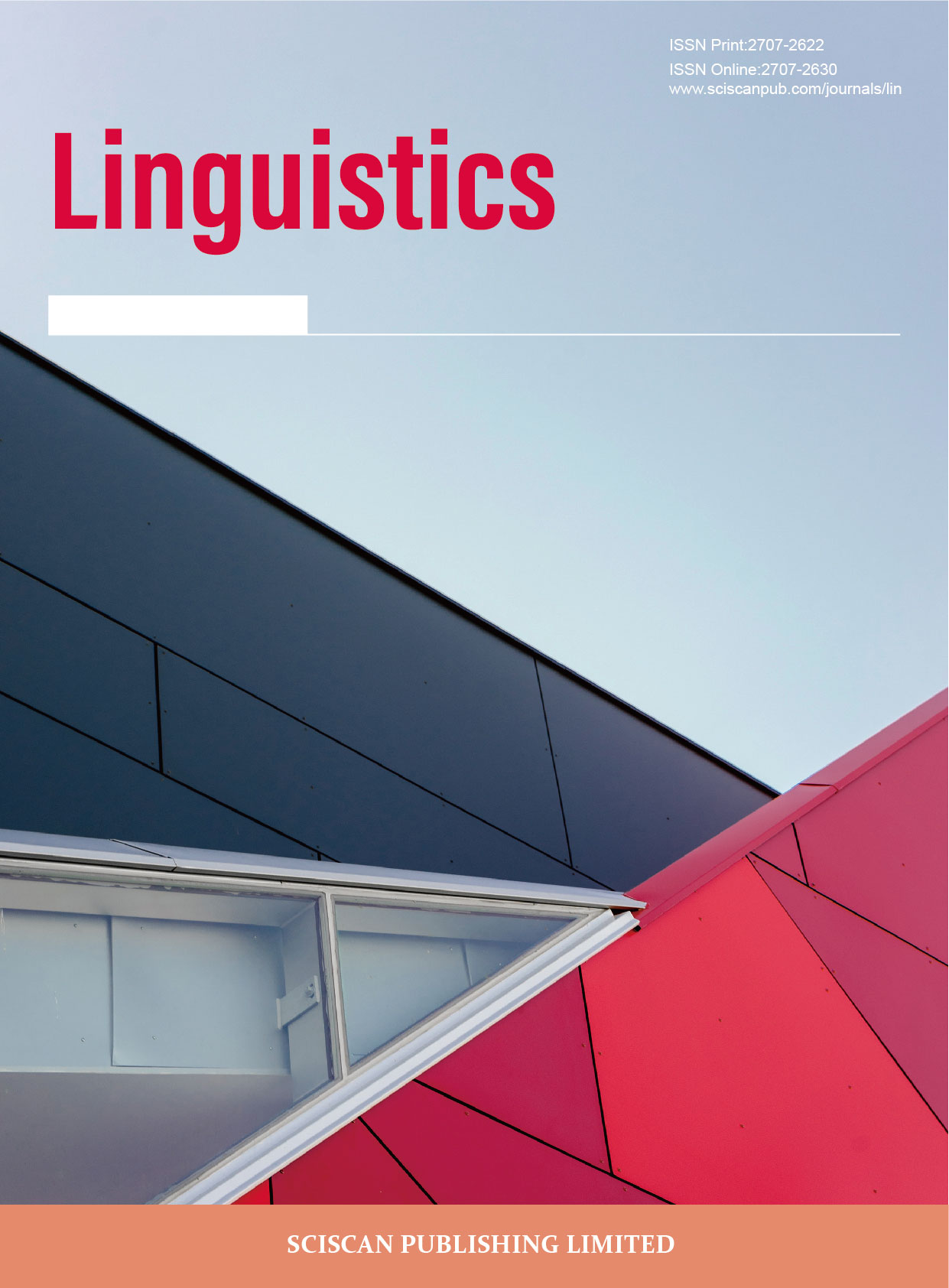中国国家形象的“他塑” ——英语词汇中汉语拼音的存在性解读
China’s Constructed National Image: The Existence of Pinyin in English Words
- Authors: 许可
-
Information:
北京邮电大学人文学院,北京
-
Keywords:
Discourse and power; Pinyin; Constructed national image; Language contact话语与权力; 拼音; 他塑; 语言接触
- Abstract: This article collects all the Pinyin words in Oxford English Dictionary and The Economist (2009-2019). It addresses the reasons for using Pinyin to discuss relevant concepts or issues and the consequent influence on China’s national image. The study draws on the theory of constructed national images, international communication laws, and the relationship between power and discourse. It arrives at the conclusion that western media uses Pinyin as media discourse power, to highlight the connection between China and the concept discussed, so as to build a negative image. Meanwhile, the constructed China’s image covers minute aspects, with more focus on cultural, social, and political issues. Suggestions are provided for self-image-shaping and self-representation. 本研究收集《牛津英语词典》及《经济学人》在2009—2019十年间出现的拼音词汇,基于国家形象的他塑理论、国际传播规律以及话语权力关系理论,分析了拼音词汇存在的四种原因及其对中国国家形象的影响。本研究得出结论:《词典》收录的拼音词汇多为反映我国独特文化、历史等的正面词汇,而以《经济学人》为代表的西方媒体使用拼音的形式探讨一些概念,是为了强化这些概念与中国的关系,利用媒体话语权力建构中国在社会、文化及政治上的负面形象。同时,国家形象的“他塑”所关注的主题细致入微,主要集中于文化、社会和政治主题,评价整体偏向负面。本研究也为国家形象的“自塑”与自我呈现提供了建议。
- DOI: https://doi.org/10.35534/lin.0603023
- Cite: 许可.中国国家形象的“他塑”——英语词汇中汉语拼音的存在性解读[J].语言学,2024,6(3):296-311.
1 引言
在语言接触的过程中,各语言都会吸收或借用外来词汇。根据萨丕尔—沃尔夫(Sapir-Whorf)假说,语言与文化和思想之间存在相关性(Carroll,1956)。针对外来概念或术语,一种语言的认知和语言表征(即,用外来语言形式体现还是用本族语言体现),可以反映出该语言使用者对外语使用者的印象、立场和态度,即对他国形象的反映。在外媒对中国的文字新闻报道和评论中,时常能看见使用汉语拼音辅以英语解释的方式直接介绍中国概念这类被动的中国表述。本研究收集《经济学人》在2009—2019年这十年内与中国相关的报道及《牛津英语词典》(以下简称《词典》)中的拼音词汇,分析这些词汇的内容以及保留拼音形式的原因,由此探索中国国家形象的“镜像”和他塑。
2 理论背景
从拼音的角度探索中国国家形象的他塑,不仅是翻译或零翻译的问题,更涉及传播学、语言学理论。具体包括国家形象的塑造理论、国际传播规律以及批评话语分析中媒体话语建构理论。
2.1 国家形象的他塑
国家形象由国内和国外综合评价而成,是对一个国家的总体评价(张昆、徐琼,2007)。评价主体包括该国内部和外部公众(管文虎,2000),可分为国内形象和国外形象(孙有中,2002)。研究国家形象的学者无论对这一概念如何界定,都指出了媒体是建构国家形象的重要途径。公众对某一国家形象的认知多来自媒体营造的“拟态环境”(徐明华,2019:22)。
国家形象的媒体塑造中存在“自塑”和“他塑”两个维度。“自塑”指本国通过官方或非官方途径宣传和塑造自我形象。“他塑”指非本国媒体或话语对该国家形象的呈现与塑造。这两者之间往往存在差异,体现在对具体事件的选择性呈现以及对该国治理方法和政策的评价之上。中国在国际形象中的自我呈现与西方媒体对中国的投射之间存在巨大反差,媒体业发展“西强我弱”是客观事实,导致我国的国际形象多为“他塑”,多为“被定位”(吴赟,2019),而“自塑”的力量较弱。
2.2 国际传播规律
国际传播的客观规律为顺流性与目的性(刘继南、何辉,2006b:21)。顺流性是指“国际上的信息主要由占主导地位的国家或强势媒体发出,并通过其所占有的有效手段和资源进行对外传播”(刘继南、何辉,2006b:22)。只要世界政治经济发展不平衡,这种顺流性就不会改变。强势媒体塑造了一种“媒介帝国主义”,遵循目的性原则,随意宣传符合自己利益和意识形态的内容,服务于媒体自身或媒体所属国家的目的,导致有些报道脱离客观性,不考虑媒体弱势国家的实际情况。而且,主流强势媒体对一个国家的报道倾向和塑造的形象会极大程度地影响国际社会对该国的印象、了解和态度(同上:49)。
2.3 媒体话语建构
Foucault(1972/2010)首次将话语与权力结合在一起,认为话语不仅是人类斗争的手段,话语本身也是目的。Fairclough(1989)的批评话语分析理论同样建构于话语的背后存在权力斗争这一理念之上。批评话语分析是一个研究语言与权力和意识形态关系的分析框架,可帮助人们抵抗以语言形式施加于人的压迫(Fairclough,1995:1)。他认为媒体通过话语运作的权力是逐渐累积而成的,体现在对因果关系和主体性特定方式的重复呈现。并且,现代主流媒体的曝光率高,产出又有规律,继而对社会重构甚至建构的影响十分强大,无处不在(Fairclough,1989:54)。因此,在审视媒体对一个国家形象的影响时,除了传播学本身的宏观规律外,也应从微观的话语层面进行分析,因为话语可被用作形象建构的工具。
3 文献综述
3.1 中国特色概念的表述
从词汇层面表述中国概念主要有两种方式:一是解释性翻译,二是以拼音或音译的形式直接进入英语。在解释性翻译方面,外文局及中国翻译研究院出版了《中国关键词》系列丛书,用14种语言介绍中国特色话语,并建设了中国特色话语对外翻译标准化术语库[1]方便随时使用和查询。关熔珍及原淼(2019)研究了《中国关键词》中关键词英译处理方式,以具体的例证和分析,总结其中四大关键词英译处理方式:仿写西方、中国特写、中西杂糅以及灵活变译。在以拼音进入英语方面,外文局(丁洁,2018)确定了100个英语新词汇中的汉语拼音来反映中国海外认知度,使用调查问卷、外媒舆情监测等方法对英语新词汇进行认知度赋值,发现代表中国道路、中国方案的词汇日益为世界民众熟知;中国经济、科技发展进步带动了世界经济与科技话语的创新;中国传统文化类汉语拼音词汇数量高居榜单之首。
英语世界获得中国相关表述大致可以来自两个途径:一是来自中国无论以公共部门还是私有部门主动进行的输出,二是英语媒体及大众传播话语根据自己的兴趣和需求来报道、探讨和表述有关中国的事情。
在中国特色词汇方面,上述实践和研究都聚焦于中国的主动输出和主动表述,但对于词汇层面的被动英语表述研究较少。我们不仅应关注自己“想讲的”,也应该关注别人“想听的”,了解其中是否有差别,以及造成这些差别的原因,进而构思解决方案。西方主流媒体对中国的报道以及《词典》这一英语世界中的权威词典对拼音词汇的收录便是一个查看被动中国英语表述的窗口。
3.2 中国国家形象的他塑
刘继南与何辉(2006a)课题组在《镜像中国》中对多家西方主流媒体进行了系统性的内容分析,课题组的结论以《中国形象》一册书单独出版进行讨论。其中,主流印刷媒体中的中国形象主要为经济蓬勃发展但存在问题、政治不断完善但亟待改善、文化博大精深、不良社会问题既多又严重,整体呈负面。
近几年,西方媒体对中国的国家形象塑造有些许变化。他们无法忽视中国在经济、军事、科技和体育等方面取得的巨大发展,但对这些发展的诠释仍然是负面的,营造出这些成就大部分来自对国际规则践踏的舆论导向。安利利与王晶莹(2020)对《华盛顿邮报》2015—2019年的涉华报道进行分析后发现,中国形象包含三个方面:一是具有强大军事力量但急于扩张,不遵守国际秩序;二是法制化不完善,言论不自由;三是拥有丰富文化资源、体育成绩优异、科技发展迅猛。刘立华与童可(2020)分析了中外关于“中美贸易战”的相关报道,得出结论:外媒在“他者”呈现中凸显我国为“践踏规则的危机制造者”形象。由此可见,改革开放以来,经过多年“他塑”的演变,核心形象没有太大变化,仍主要偏向负面,体现“中国威胁论”“中国不确定论”。(吴赟,2019)
4 研究设计
4.1 研究对象
汉语拼音进入英语语言的途径是多元的。在书面材料中,权威英语词典和主流英语媒体是具有代表性的途径。被收录至词典的词汇具有历时性,可显示在历史长河中英汉语言接触和互动多年后被英语吸收的拼音词汇,能够反映经过时间积淀后英语认为有必要以拼音形式保留的中国相关概念。相对于词典,主流媒体的报道更能体现时效性,展现外媒关注中国较新的现象。
本研究选择《经济学人》作为主流媒体代表,收集2009—2019年这十年中与中国相关的报道。《经济学人》是英国具有影响力的大型综合性周刊。该周刊文章篇幅均为中等长度或较长的深度报道,专业性强,具有前瞻性,是政商界精英、各国首脑、要人获取信息的主要媒体(刘继南、何辉,2006a:117)。因此,《经济学人》对中国的报道、呈现以及形象塑造会对其目标读者对中国的态度和立场产生较大影响。
4.2 研究问题
(1)具体有哪些概念在外媒表述中国时被以拼音的形式呈现?
(2)在表达外来概念时,使用英语解释的方式对于英语读者来说接受性更好、信息传达效率更高,出于何种原因他们不选择使用英语解释的方式传达这些中国概念?
(3)拼音词汇如何反映我国国家形象的他塑?
4.3 研究及检索方法
使用《词典》在线数据库,选择高级搜索,选定词源为中文、使用情况为目前正在使用的词汇,进行词条检索。词条中有诸多闽南语或粤语发音的词汇,由于本研究只考虑以拼音形式进入英语的词汇,因此对非拼音形式的词汇进行剔除,最终统计获得拼音词汇。使用《经济学人》网站检索2009—2019年这十年的文章,逐刊查阅与中国相关的内容,统计所有以拼音形式出现的词汇。该报刊每次引入拼音均使用斜体,其体例中任何外语词汇均用斜体表示,并在拼音后面注明字面直译和内涵解释。如对“汉服”的解释是 “以传统汉民族服饰为灵感设计的长袍”(Chaguan,2019)。
5 结果与讨论
《经济学人》近十年与中国相关的文章中拼音词汇以类符计算共计191个词。《词典》中中文词源且筛除粤语及闽南语发音后,共计65个词。上述两个来源的词汇被进一步分为社会现象、社会制度、文化、饮食、教育、经济金融、政治历史、科技、音乐等类别。
表 1 以汉语拼音形式出现在《牛津英语词典》和2009—2019年《经济学人》中的词汇及分类
Table 1 Words appeared in pinyin in the Oxford English Dictionary and The Economist (2009-2019), and the classifications of these words
|
分类 |
《经济学人》中出现词汇(按类符统计) |
《牛津英语词典》收入词汇(按类符统计) |
|
教育 |
高考、军训 |
|
|
文化 |
打卡、打卡族、旦、地域黑、斗地主、二人转、风水、汉服、内部、网红、幸福、代购、茶馆、华侨、单位、族谱、全中国的儿童永远想太平、洋垃圾、全球、全球化、屌丝、本分、莎士比亚、七上八下、阿訇、清真、邻避、小粉红、肚兜、春晚,气,毽子,关系,小子,耽美,放生,阅兵蓝,避孕套,富,绯闻,物流,秘书,315,单飞,脱口秀,圣诞节,人情,山寨,广场舞,少林,太极,下海,千万富翁,真的假不了,茄子(拍照用语),普世价值,拖拉机 |
彝,禅,风水,干部,干杯,关系,红包,炕,梅瓶,苗,闽,冥,南洋,气,气功,旗袍,神,武术,武侠,阴,阳,生(戏剧),玉兰 |
|
旅游 |
特色小镇,农家乐,胡同,月坛,地坛,天坛,万牲园,雪龙,西藏 |
胡同,牌楼 |
|
体育 |
黑哨,假球,围棋 |
|
|
饮食 |
白酒,宫保鸡丁,奶盖茶,小龙虾,金拱门,麦当劳,宝马,可口可乐,营养包 |
包子,茶,饺子,馒头,茅台,面 |
|
社会制度 |
户口,低保,档案,派出所,便民卡,地票,网格,进出,青进青出,川进青出,新进,劳教,改制,城管 |
|
|
社会现象 |
北漂,黑社会,巨婴,蚁族,我也是,同志,同性恋,留守儿童,养儿防老,富二代,光棍,剩女,民工,棒棒人,春运,高富帅,白富美,海龟,海带,文艺青年,普通青年,首都/首堵,跑官,族,啃老族,嫁碗族,闪婚族,隐婚族,蜗居族,奔奔族,房奴,婚奴,孩子奴,月光族 |
|
|
科技 |
嫦娥四号,伊妹儿,电邮,玉兔,高铁,嫦娥三号,蛟龙,大洋一号,天宫, |
里,厘,两,青蒿素,垧,推拿 |
|
语言文字 |
普通话,你好,拼音、弟子规 |
拼音,注音字母,普通话,楷书,隶书 |
|
经济金融商业 |
股市,计划,规划,胡润富豪榜,领英,伟哥,乔丹 |
分,角,人民币,元 |
|
政治历史 |
太子党,盛世,内参,常任制,改革开放,政审,双规,国进民退,保家,内松外紧,访惠聚,同意出关,登机/登基,思想,理论,观,韬光养晦,领导小组,外事无小事,一带一路,中国方案,爱国爱港,软实力,核心,习大大,彭妈妈,大换届,带病,法制,维权,死墙,进士,富强,兵团,奴,代表团,大字报,《瞭望》 |
院,三反,明,秦,清,商,宋,隋,太平(天国),唐,魏,元(朝) |
|
音乐 |
笛子,扬琴,唢呐,铙钹,葫芦丝 |
笛子,律,琵琶,笙,瑟,琴,唢呐 |
5.1 一种语言表达外来概念的方式
一种语言用来表达外来概念的方式有多种,按照该概念在两种语言中表述对应的程度,由高至低可分为解释性翻译、代码转换型翻译、音译形式。
解释性翻译是指某个外来概念属于源语国家特有概念,在本国语言中无法找到直接且词性相同的对应表达,但这一概念通过解释可以使本国人理解。目前我国的对外话语体系建设在关键词上的努力基本通过这种方式达成,如“命运共同体”译为“community of a shared future”。这类独具中国特色的政治话语所表达的概念在英文世界中不存在,但相对于直接使用拼音(音译)的方式来说,我们认为最好通过使用英语语言现有词汇进行解释的方式向英语世界引介我们的政治观念,这样更易被接受。这是我们“积极发声,又要使发出的声音能被他人听懂和认可”(江时学,2016)所做的努力。
代码转换型翻译同样适用于目的语语言没有直接对应的表达,同时又不对概念进行解释,仅进行机械代码转换,如“纸老虎”被译为paper tiger进入牛津词典和英语世界。此类代码转换式翻译的结果可能无法直接让目的语国家的使用者理解,需要背景知识。在接触语言学中,音译指外来词或借词(loan word),音义兼借(张兴权,2012:102),“浑然一体,不可分离”(吕淑湘,1957:12)。
常见的音译词为人名地名,但也有越来越多非人名地名词汇使用这种方式在目的语中进行表达。本文所考察的汉语以拼音的方式进入英语便属于这一类。英语以音译方式进入汉语的词汇例子也较多,如“robust”被译为“鲁棒性”,意为控制系统或计算机软件的稳定性、强韧性。由于英汉两种语言从属不同文字表达体系,才会将音译与直接使用源语形式表达区分开。如英法两种语言皆使用拉丁字母文字体系,便没有此类区分。因此会出现“Walkman”(随身听)直接用于法语文字表述,以及“rendez-vous”(会面地点)直接用于英语文字表述。使用英语源语形式在汉语日常生活中直接表达的案例有许多,如“WIFI”“B超”“Type-C接口”等。
5.2 以拼音形式保留中国相关概念的原因
英语作为一个兼收并蓄、包容的语言,一直以开放的态度接纳来自各个语言的词汇。目前《词典》在线版已收录约60万词汇[2]。相比之下,法语仅有7.5万个词汇。因此,英语相对于其他语言来说表征能力强,在遇到外国较独特概念时应有能力通过解释型翻译或代码转换型翻译来表达。根据Venuti(1995/2008)的归化异化翻译理论,音译是异化的一种极端形式。以音译的形式进入一个语言需要使用者花更多精力学习和理解这种用法。英语在试图表达汉语中较为独特的概念时,如果选择以拼音这种极端异化的形式表达,大致有四种可能:一是这一概念的内涵较为深刻,对其解释需要较多词汇,且仍然无法准确解释该概念在该国语境中的确切意义。二是选择性将这种概念引入英语,增强其曝光率,巩固这一概念与源语国之间的关系,加深英语使用者对源语国的特定印象。“相对于第三世界语言来说,西方语言更有能力可以制造和使用他们想要的知识”(Asad,2010)。此时,他们在选择哪些拼音可以进入词典,选择使用哪些拼音词汇讨论中国事情时具备主动权。三是这一概念在最初引入英语时不存在对应表达,但后期创造出对应表达、且对应表达广为使用后,便不再使用原有拼音词汇。四是某一概念源自中国科技或理论的创新与突破,命名权由中国掌握,对该概念进行引介和讨论时不得不使用拼音。
5.3 《词典》收录拼音的分析
《词典》中收录的大部分拼音词汇所表述的概念,在英语中无法找到直接对应的概念,且无法简单明确地解释,如“风水”“阴阳”。这类词汇脱离中国语境便不存在,是中国独有的概念。《词典》收录拼音的原因主要是上文中所述的原因一。《词典》中收录的文化类词汇(27个)数量最多,其中包含我们认为属于优秀文化传统的“旗袍”“武术”“武侠”,也有具有建筑特色的“胡同”“牌楼”。其次是政治历史类词汇(12个),包含我国部分朝代的名称。值得关注的是,类似“笛子”“琴瑟”这类我国独有的乐器和乐理词汇也在《词典》中占有一席之地。但也有一些概念存在于西方语境,如“茶”虽然源自中国,但在西方也极为流行,而且有“tea”这一直接对应词汇,然而“cha”仍然以拼音的形式进入了《词典》。该词条的解释为:汉语中“tea”的对应词汇,在英语中最初引入这种饮料时偶尔使用,后来也有人用这个词来形容中亚地区一种特殊的手撵茶。这说明“cha”只是很早以前被收录到《词典》中,但后续使用不多,属于上述原因中的第三种。
值得关注的是“关系”一词。《词典》对“关系”一词的解释为:在中国语境下,人们可以用于职业或其他利益的个人和社会关系网络。但在英文语境中,“connections”一词也有类似意思。比如在《傲慢与偏见》中,夏洛特告知伊丽莎白她将嫁给伊丽莎白的表兄柯林斯时说道:“就柯林斯先生的性格、亲属关系(connections)和社会地位来看,我相信嫁给他是能够获得幸福的,可能性之大,不会亚于大多数人结婚时夸耀的那样”(奥斯汀,2010)。《经济学人》在一篇特别报道中也提到达沃斯会议是全球政商界精英及领袖建立关系的良好平台,并开发了一套在线系统专门为这些精英和领袖在开完会回去之后继续保持关系(“A world of connections”,2010)。显然,在英语语境中,人们也需要社会关系来服务自己的职业和利益,这一概念并非中国独有。然而,仍然将“关系”一词引入词典中,可能是因为想要增强这一概念与中国的关系,进而在英语使用者脑海中强调中国人讲关系、而非贤能为重的特点,属于上文中第二种原因。
5.4 《经济学人》收录拼音的分析
经济金融是《经济学人》最为重要的板块,而在这两个版块内对中国的讨论很少有以拼音形式出现的词汇。这主要是因为英语词汇足够丰富并且擅长讨论这两个主题的内容。出现拼音较多的板块为政治、社会、文化,科技板块收录拼音虽数量不多,但值得关注。
5.4.1 文化主题
《经济学人》近10年间出现的拼音词汇中与文化相关的有“地域黑”“斗地主”“二人转”等。这些明显不属于我国想要对外宣传的优秀中华文化。讨论“二人转”的文章(“China’s north-east is the home of bawdy song-and-dance”,2019)非常直接地讨论了这一民间艺术形式所保留的粗俗成分。这与我国更乐意宣传的秦腔、京剧等优秀文化相差甚远。“斗地主”“二人转”虽不属于优秀文化,但也无法构成社会问题,并不能以西方媒体揭露社会问题的自我定位来解释对这类中国文化现象的偏重报道。这类报道体现了《经济学人》对此类文化的价值判断,或者对中国现当代社会的评价。
5.4.2 社会主题
《经济学人》对转型中的中国所出现的新兴社会现象尤为关注,比如“留守儿童”“剩女”“月光族”等。其中“户口”是出现频率最高的词汇。这一词汇并未收录至《词典》中。“户口”作为我国特色社会管理制度,在西方国家没有对应概念,而且许多《经济学人》所关心的社会问题,如“留守儿童”“民工”主要来源于户口制度。“网红”“打卡”“代购”也吸引了外媒的注意,该杂志有专题报道向对中国感兴趣的英语世界人士介绍这些现象。社会主题的概念以拼音形式出现的原因是上述第一种,或第一种与第二种的结合。
5.4.3 政治主题
在政治方面,《经济学人》以拼音形式介绍了许多中国政治核心话语与指导思想方针,如“改革开放”“一带一路”“富强”“法制”等。在讨论法制时,该报强调了“法制”与“rule of law”的区别,指出中国语境中的“法制”是“基于法律的治国”,指法律是党用于维护秩序的一个工具,凸显“法制”一词在中国语境中与西方语境中的区别。
我国管理新疆地区使用的“访惠聚”政策,以及“便民卡”都在该报中有文章详细介绍,在某种程度上说明外媒对我国政策的关注已达到面面俱到、细致入微的程度。
5.4.4 科技主题
科技板块下收录的拼音词汇反映了我国在航天航空、铁路及海洋科技上的最新突破性进展,包括嫦娥四号、高铁、蛟龙、大洋一号、天宫等。使用拼音词汇探讨科技主题主要出于上述原因四。
5.5 《词典》与《经济学人》收录拼音词汇的对比
二者收录拼音词汇的数量存在较大差异。《词典》自编纂以来仅收录65个拼音词,而《经济学人》近10年间便收录了191个词。主要原因在于词典词条在收词原则上区别于杂志或报纸,需要具备稳定性、规范性,要慎重对待新词。收录词汇“需有明确性或特有的表现力,语言中没有别的词能够替代它”(晁继周,1995)。相比之下,《经济学人》中引入大量以拼音形式出现的新词来探讨中国新的现象,有些词汇在不久之后可能会消失。因此相对于《词典》来说,《经济学人》在引入新词时自由度更大,无需过多考虑词汇的历史性、传播广度与稳定性。
《词典》收录的大部分词汇可反映中国优秀的传统文化、饮食、历史等,而《经济学人》虽然在科技方面使用拼音介绍了我国航天及海洋探索的尖端科技,但在文化、政治、社会现象等方面引入的大部分词汇偏向负面。
6 结论
本研究认为,《词典》收录的拼音词汇多为反映我国独特文化、历史等的正面词汇,而以《经济学人》为代表的西方媒体在讨论中国概念时使用拼音的形式进行表达,是为了强调这些概念与中国的关系,在这些概念的基础上加强塑造相关中国形象。可以看出,“他塑”所关注的现象愈发微观,重点在于文化和社会,体现出快速转型的社会中百姓生活压力较大、较为现实,城市化迅速,“户口”制度的存在不利于人口自由流动和自由发展。年轻人心理不成熟、不攒钱、在婚育问题上与上一代人想法差异大。《经济学人》对文化的关注重点并非我国传统优秀文化,而是一些较新、较热的负面或中立文化,如“地域黑”“山寨”“代购”“打卡”等,反映出百姓虚荣、有偏见的不良心态。相比2006年“他塑”中的中国整体形象,总体价值判断没有太大变化,只是关注的现象更新更“热门”。
《词典》收录的词汇大部分与我国历史、饮食及优秀文化相关。《经济学人》所探讨的部分社会现象及文化并非我国想宣传的优秀文化和优秀社会现象,这主要出于该媒体本身对朴素自由市场价值理念的支持,以及一贯对各国任何偏离自由市场理念的政治、经济现象都持谨慎批判态度(包括英国)。
7 对“自塑”的建议
我们无法强迫西方改变因历史、政治因素而对我国产生的偏见,但我们仍然可以通过积极讲好中国故事、以学术创新占领命名及解释先机的方式更好地进行“自塑”。积极构建对外话语体系,对中国关键词做出权威解释便是方向正确的努力。这样可为外媒讨论中国相关概念时提供准确的依据、权威的解释,避免理解上的差异和分歧。无论在科技还是人文领域的学术创新都可以对自己所创造的知识——新技术、新发现、新概念、新理论进行命名和解释,以汉语命名和解释的这些新知识在进入英语或其他语言时便可以更有力地保留源语的成分。如今英语大量进入汉语的词汇主要集中在科技领域,尤其是信息技术领域中大量英文缩写不经过翻译直接为业内人士使用。反观之,我国进入科技领域的词汇少之又少。在本研究的数据中值得骄傲的是“嫦娥四号”和“青蒿素”的出现,分别代表着我国航天领域取得的突破性进展以及达到诺贝尔医学奖水平的发现。如果想要扭转这种趋势,语言是次要的,核心竞争力是科技和人文领域的创新能力。
本研究存在一定局限性,以《经济学人》为典型案例反映西方媒体不够全面。未来还可在更大范围、更长时间段内监测西方媒体舆论,探索多家媒体在近10年或20年以来使用的拼音词汇,便可更加全面地了解以拼音为代表的中国话语在海外的认知度和接受度。对拼音进入词典的研究也可以扩展至其他英语或美语词典,如柯林斯、麦克米伦、剑桥英语词典等。
参考文献
- Asad T.The Concept of Cultural Translation in British Social Anthropology[M]//In M.Baker (ed.),Critical Readings in Translation Studies.London and New York:Routledge,2010:7-27.
- Austen J.Pride and Prejudice an Annotated Edition[M].Cambridge and London:The Belknap Press of Harvard University Press,2010.
- Carroll J B.Language,Thought,and Reality Selected Writings of Benjamin Lee Whorf[M].Cambridge,MA:the M. I. T. Press,1956.
- The Economist.Chaguan.Why young Chinese are sporting 1,800-year old fashions[EB/OL].(2019-01-12)[2024-04-28].https://www.economist.com/china/2019/01/12/why-young-chinese-are-sporting-1800-year-old-fashions.
- The Economist.China’s north-east is the home of bawdy song-and-dance[EB/OL].(2019-03-14)[2024-04-28].https://www.economist.com/china/2019/03/14/chinas-north-east-is-the-home-of-bawdy-song-and-dance.
- Fairclough N.Language and Power[M].London and New York:Longman,1989.
- Fairclough N.Critical discourse analysis:the critical study of language[M].London and New York:Longman,1995.
- Foucault M.The Archaeology of Knowledge and the Discourse on Language[M].New York:Vintage Books,1972/2010.
- Venuti L.The Translator’s Invisibility:A History of Translation[M].London and New York:Routledge,1995/2008.
- The Economist.A world of connections[EB/OL].(2010-01-30)[2024-04-28].https://www.economist.com/special-report/2010/01/30/a-world-of-connections.
- 安利利,王晶莹.中国形象的“他者”镜像——《华盛顿邮报》涉华报道分析(2015-2019)[J].国际传播,2020(4).
- 简·奥斯汀著,孙致礼译.傲慢与偏见[M].南京:译林出版社,2010.
- 晁继周,单耀海,韩敬体.关于规范型词典的收词问题[J].语言文字应用,1995(2).
- 丁洁.英语新词汇中的汉语拼音——中国话语海外认知度实证研究[J].新闻记者,2018(6).
- 关熔珍,原淼.当代中国关键词英译与对外话语体系建设研究[J].中国文化研究,2019(1).
- 管文虎.国家形象论[M].成都:电子科技大学出版社,2000.
- 刘继南,何辉.镜像中国:世界主流媒体中的中国形象[M].北京:中国传媒大学出版社,2006a.
- 刘继南,何辉.中国形象——中国国家形象的国际传播现状与对策[M].北京:中国传媒大学,2006b.
- 刘立华,童可.框架理论视角下国际形象的媒体话语建构研究——以“中美贸易战”报道为例[J].山东外语教学,2020(41):39-49.
- 吕淑湘.中国文法要略[M].上海:商务印书馆,1957.
- 孙有中.国家形象的内涵及其功能[J].国际论坛,2002(5):15-21.
- 吴赟.国家形象自我建构于国家翻译规划:概念与路径[J].外语研究,2019(3):72-78.
- 习近平.习近平谈治国理政(第一卷)[M].北京:外文出版社,2014.
- 徐明华.中国国家形象的全球传播效果研究[M].武汉:华中科技大学出版社,2019.
- 张广昭,陈振凯.习近平如何向世界讲中国故事?[N/OL].人民日报海外版.(2017-02-22).http://paper.people.com.cn/rmrbhwb/html/2017-02/22/content_1752162.htm.
- 张昆,徐琼.国家形象刍议[J].国际新闻界,2007(3):11-16.
- 张兴权.接触语言学[M].北京:商务印书馆,2012.
[1] http://210.72.20.108/index/index.jsp 。
[2] OED(Oxford English Dictionary):About.Retrieved January 6th,2020,from https://public.oed.com/about/
















